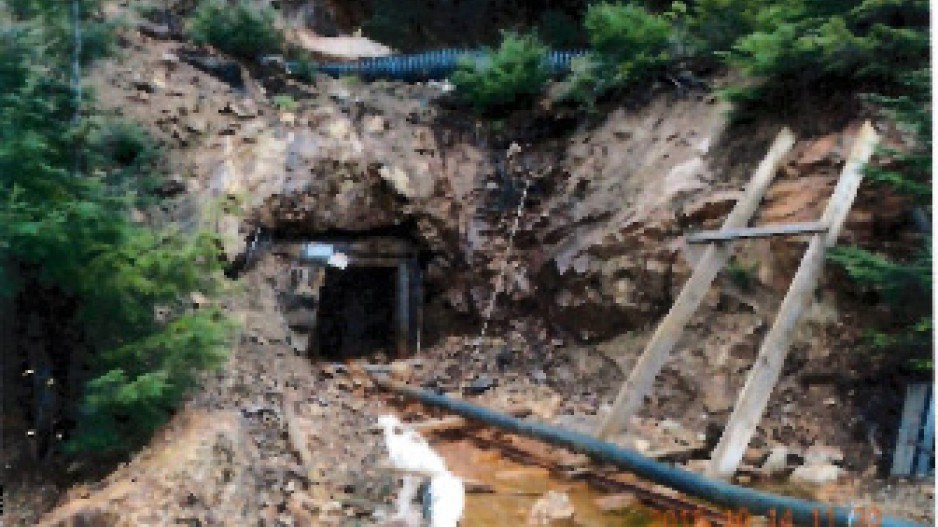An abandoned metals mine near Atlin, B.C. that Chieftain Metals Corp. (TSX-V:CFB) wants to restart has been given 90 days to clean up its act.
Following a site inspection of the Tulsequah mine in October, the Ministry of Energy and Mines recently issued a cleanup order, based on a number of permit violations related to tailings management.
The Tulsequah mine, located 100 kilometres south of Atlin and 65 kilometres northeast of Juneau, Alaska, is a small underground zinc-gold-copper mine that had been in operation in the 1950s, leaving a legacy of acid drainage problems.
Previous attempts to restart the mine failed. Redfern Resources received a permit in 2007, but went bankrupt.
The mine was acquired by Chieftain Metals in 2010. The company plans to restart the mine at capital cost of $198 million.
The mine has no tailings pond and has problems with acid drainage flowing from abandoned mine works.
In 2010, the company received a $5 million loan from Teck Resources (TSX:TCK.B) to build a water treatment plant to address the mine’s drainage issues, but it had to be shut down less than a year after it went into operation when it was found to be operating “below design level of efficiency.”
Since the mine has no tailings pond, the plan was to treat tailings before disposing of them underground. But since the mine isn’t in operation yet, there’s nowhere to put the treated legacy waste, so it is being temporarily stored in sludge pits.
Last month’s inspection revealed that acidic runoff was being “directly discharged” into the Tulsequah River without the approval of the Ministry of Environment.
It also found a sludge pond was built without ministry approval and identified problems with monitoring and maintenance, including a drainage pipe that requires ongoing monitoring and maintenance because it is prone to being crushed by falling rock, causing leaks.
It also found a buildup that nearly caused a sludge containment pit to overflow – something that was not properly reported to the Ministry of Energy Mines.
The ministry has given the company 90 days to address the problems.
Meanwhile, since the mine project was first proposed in 2010, prices for zinc, gold and copper have crashed, raising questions about the mine’s economics.
The estimated capital cost to restart the mine and bring it into production is $198 million.
Based on the a 2014 feasibility study, Mickey Fulp, who publishes the Mercenary Geologist newsletter, wonders if the project will be able to raise the necessary financing.
A low Canadian dollar and low oil prices is one advantage that the project may have today that it didn’t have in 2014, Fulp said. But that has to be offset by low commodity prices and their impact on the rate of return that the company had been projecting.
Since the 2014 feasibility study was done, gold has fallen from US$1,258 per ounce to US$1,107 per ounce, copper has fallen from US$3.08 to US$2.12 per pound (a six-year low) and zinc has fallen from US$1.06 to US$0.69 per pound.
As Fulp points out, the feasibility study put the net present value of the mine at $221 million and capital cost at $198 million.
“That’s a big red flag right there,” Fulp said. “That’s only 10% of the capital cost. You’re going to go raise $200 million to make for a net present value of $220 million? Who’s going to finance this?
“It was marginally economic at the price deck they ran a year ago. Who’s going to put money into this at this day and age?”
If Chieftain can’t raise the money to build the mine, it raises the question of who will be responsible for addressing the ongoing problem of metal leaching and acid drainage.
Chris Zimmer, Alaska campaign director for River Without Borders, said the orders issued from the Ministry of Energy and Mines were “weak” because it states the company doesn’t have to start doing water treatment until the mine reopens.
“The question is what if they never reopen the mine?” Zimmer said. “It’s the B.C. government’s responsibility to enforce the law and make sure that project is done properly. And if Chieftain fails to do it, B.C. can’t just throw up their hands and say ‘Oh well, the company failed.’
“There’s two options here: You either run that treatment plant forever at $4 million a year and all the maintenance that requires, which doesn’t really seem feasible, or you close down the mine, reclaim the site and, at its source, you stop the movement of water, stop the creation of acid mine drainage and you basically just plug it up and walk away.”
Calls to Chieftain Metals were not returned.




